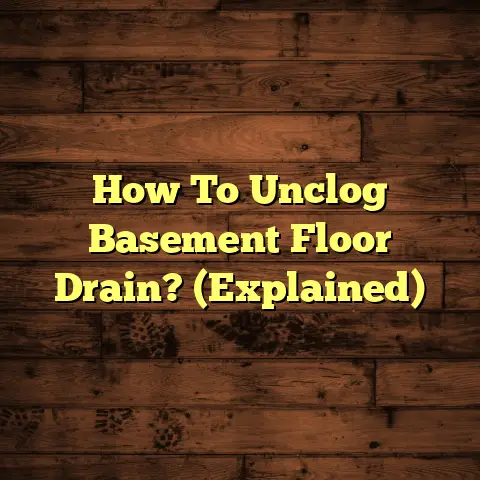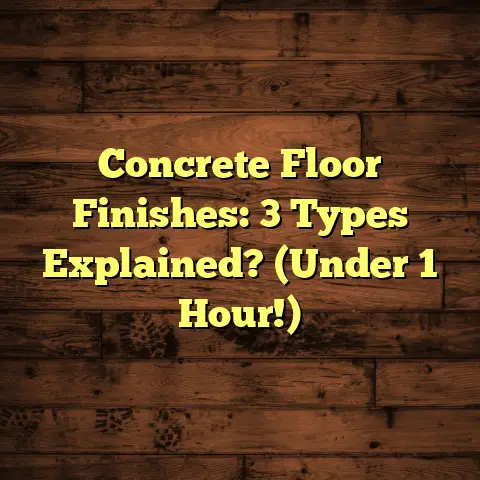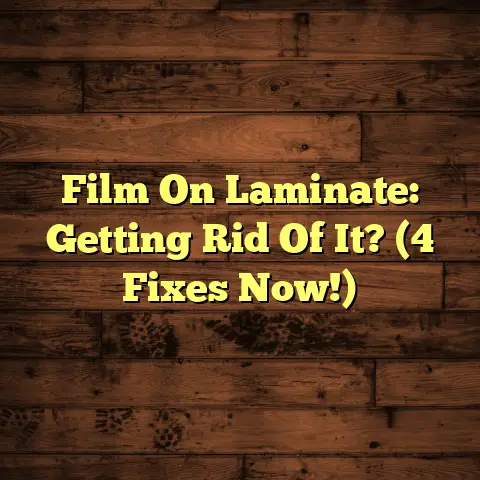Paint Garage Floors? (2 Coatings Warn!)
Think about it: the color, the texture, the overall design of a floor can completely transform a room. A sleek, modern tile can make a kitchen feel cutting-edge, while warm, rustic hardwood can create a cozy living room vibe. It’s all about the feeling you want to create.
Now, let’s talk garages. Often, they’re the forgotten canvas, right? Just a dull, gray slab of concrete. But guess what? Your garage has potential! A well-designed garage floor can turn a utilitarian space into something vibrant and inviting.
I’ve seen firsthand the emotional impact of a great garage floor. Homeowners take pride in their space, they’re more likely to keep it organized, and honestly, it just makes working on projects more enjoyable. And that’s where painting comes in.
Painting your garage floor is a popular way to add protection and a splash of personality. It’s a DIY project that can make a huge difference. But like any project, it’s essential to do it right. And that’s why I’m here to share my insights and warn you about the importance of those two crucial coatings!
Section 1: The Benefits of Painting Garage Floors
So, why bother painting your garage floor? Let’s dive in!
1.1 Aesthetic Appeal
Let’s face it, bare concrete isn’t exactly a design statement. But a painted floor? Now that’s something! I’ve seen garages transformed from drab to fab simply by adding color.
Think about it: a bright, clean white can make a small garage feel bigger and brighter. A bold, dark gray can give it a modern, industrial edge. You can even get creative with patterns – checkerboard, stripes, or even custom designs.
Here’s a quick example from my own experience: I helped a client with a classic car collection. We painted his garage floor a glossy black with a white checkered pattern. It instantly elevated the space, making it feel like a showroom for his prized vehicles. The visual impact was incredible!
1.2 Durability and Protection
Beyond the looks, paint acts as a shield for your concrete. Garages take a beating, right? Cars dripping oil, tools being dropped, and all sorts of spills. Unprotected concrete soaks all that stuff up, leading to stains, cracks, and deterioration.
Paint creates a barrier that protects against all that. It prevents oil, grease, and other chemicals from penetrating the concrete, making it easier to clean up messes. Plus, it helps prevent chipping and cracking caused by heavy use.
According to a study by the Portland Cement Association, sealed concrete floors can last up to twice as long as unsealed floors. That’s a significant increase in lifespan!
1.3 Easy Maintenance
Cleaning a bare concrete floor can be a nightmare. Those porous surfaces trap dirt and grime, making it tough to get a truly clean surface. But a painted floor? A breeze!
The smooth, non-porous surface of painted concrete makes it easy to sweep, mop, or even hose down. Spills wipe up quickly, and dirt doesn’t get ground into the surface.
I tell my clients, “Think of it like this: you’re trading a tough scrub for a quick wipe.” That’s a trade-off I’ll take any day!
1.4 Increased Home Value
A well-maintained, attractive garage can definitely boost your home’s value. Think about it from a buyer’s perspective: a clean, organized garage signals that the home has been well cared for.
A painted garage floor is a relatively inexpensive upgrade that can make a big impact. It shows that you’ve taken pride in your home and paid attention to the details.
Real estate experts estimate that a renovated garage can add anywhere from 1% to 5% to your home’s value. That might not sound like a lot, but it can translate to thousands of dollars, depending on your home’s price.
Section 2: Choosing the Right Paint for Garage Floors
Okay, so you’re sold on painting your garage floor. Great! But before you grab any old can of paint, let’s talk about choosing the right product. This is crucial for a long-lasting, beautiful finish.
2.1 Types of Floor Paint
There are several types of paint suitable for garage floors, each with its own pros and cons. Let’s break them down:
-
Epoxy: Epoxy paints are known for their exceptional durability and resistance to chemicals, stains, and abrasion. They’re typically two-part systems that require mixing a resin and a hardener. Epoxy provides a hard, glossy finish that’s ideal for high-traffic areas.
-
Latex: Latex paints are water-based and easier to apply than epoxy. They’re also less expensive and have lower VOC (volatile organic compound) emissions. However, latex paints aren’t as durable as epoxy and may not hold up as well to heavy use or chemical spills.
-
Urethane: Urethane paints offer a good balance of durability and flexibility. They’re more resistant to UV damage than epoxy, making them a good choice for garages that get a lot of sunlight. Urethane paints are also available in a variety of finishes, from matte to high gloss.
Here’s a quick comparison table:
| Paint Type | Durability | Ease of Application | Cost | Chemical Resistance | UV Resistance |
|---|---|---|---|---|---|
| Epoxy | Excellent | Moderate | Higher | Excellent | Fair |
| Latex | Fair | Easy | Lower | Fair | Good |
| Urethane | Good | Moderate | Moderate | Good | Excellent |
2.2 Understanding Coatings
Now, let’s get to the heart of the matter: one-part vs. two-part coatings. This is where that “two coatings warn” in the title comes into play!
-
One-Part Coatings: These are typically latex-based paints that come pre-mixed and ready to apply. They’re convenient and user-friendly, but they generally don’t offer the same level of durability or chemical resistance as two-part coatings.
-
Two-Part Coatings: These are usually epoxy-based systems that consist of a resin and a hardener. You have to mix them together just before application. This chemical reaction creates a much stronger, more durable coating that’s highly resistant to wear and tear.
The “two coatings warn” refers to the fact that even with a high-quality two-part epoxy, you almost always need two coats. Why? Because the first coat acts as a primer, soaking into the concrete and providing a base for the second coat to adhere to. The second coat provides the full level of protection and the desired finish.
Skipping the second coat is a recipe for disaster. You’ll likely end up with a floor that’s prone to chipping, peeling, and staining. Trust me, I’ve seen it happen!
2.3 Color and Finish Options
Once you’ve chosen the type of paint, it’s time to think about color and finish. This is where you can really let your creativity shine!
-
Color: The color of your garage floor can have a big impact on the overall feel of the space. Light colors can make a garage feel brighter and more spacious, while dark colors can add a touch of sophistication. You can also use color to create zones within your garage, such as a designated workspace or parking area.
-
Finish: The finish refers to the level of sheen or gloss of the paint. Common options include:
- Gloss: High-gloss finishes are very reflective and easy to clean. They’re a good choice for garages where you want a bright, clean look.
- Satin: Satin finishes have a lower sheen than gloss and are more forgiving of imperfections in the concrete.
- Matte: Matte finishes have very little sheen and provide a more subtle, understated look. They’re a good choice for garages where you want to minimize glare.
2.4 Choosing Based on Usability
Finally, consider how you’ll be using your garage. Is it just for parking cars? Or will it also serve as a workshop, storage area, or even a home gym?
If you’ll be working on cars or other projects that involve chemicals, you’ll want to choose a paint that’s highly resistant to spills and stains. Epoxy is often the best choice in this case.
If you’ll be using your garage for storage, you might want to choose a paint that’s resistant to abrasion and wear. Again, epoxy or urethane would be good options.
And if you’ll be using your garage as a home gym, you might want to choose a paint that provides a good level of traction, even when wet. Some paints have slip-resistant additives that can help with this.
Section 3: Preparing Your Garage Floor for Painting
Alright, you’ve picked your paint. Now comes the not-so-glamorous, but absolutely crucial part: preparation. I can’t stress this enough: proper prep work is the key to a successful, long-lasting paint job.
3.1 Assessing the Current Condition
First, take a good, hard look at your garage floor. What’s the condition like? Are there cracks, chips, or stains? Is the surface smooth or rough?
Here’s what to look for:
- Cracks: Small hairline cracks are common, but larger cracks need to be repaired before painting.
- Chips: Chipped concrete can create an uneven surface that will be visible through the paint.
- Stains: Oil, grease, and other stains can prevent the paint from adhering properly.
- Existing Coatings: If your floor has been previously painted or sealed, you’ll need to remove the old coating before applying new paint.
3.2 Cleaning the Surface
Next, you need to thoroughly clean the garage floor. This means removing all dirt, dust, grease, and other contaminants.
Here’s my go-to cleaning process:
- Sweep: Start by sweeping the entire floor to remove loose debris.
- Scrub: Use a stiff-bristled brush and a degreasing cleaner to scrub the floor. Pay special attention to areas with stains.
- Rinse: Rinse the floor thoroughly with clean water.
- Dry: Allow the floor to dry completely before proceeding. This could take several hours or even overnight.
For stubborn stains, you might need to use a specialized concrete cleaner or degreaser. I’ve had good results with products like Simple Green and Krud Kutter.
3.3 Repairing Damage
Before you start painting, you need to repair any cracks or chips in the concrete. This will create a smooth, even surface for the paint to adhere to.
Here’s how to repair minor cracks and chips:
- Clean: Clean out the crack or chip with a wire brush to remove any loose debris.
- Fill: Fill the crack or chip with a concrete patching compound.
- Smooth: Use a putty knife to smooth the patching compound flush with the surrounding concrete.
- Cure: Allow the patching compound to cure according to the manufacturer’s instructions.
For larger cracks or more extensive damage, you might need to consult a professional concrete repair specialist.
3.4 Etching the Surface
Finally, and this is super important, you need to etch the concrete surface. Etching creates a slightly rough texture that allows the paint to adhere properly.
Concrete is naturally very smooth, which makes it difficult for paint to grip. Etching opens up the pores of the concrete, creating a mechanical bond that helps the paint stick.
There are two main ways to etch concrete:
- Muriatic Acid: Muriatic acid is a strong acid that can effectively etch concrete. However, it’s also very dangerous and must be handled with extreme care. Always wear protective gear, including gloves, eye protection, and a respirator, when working with muriatic acid.
- Citric Acid: Citric acid is a gentler, more environmentally friendly alternative to muriatic acid. It’s also less hazardous to handle.
Regardless of which method you choose, follow these steps:
- Apply: Apply the etching solution to the concrete surface according to the manufacturer’s instructions.
- Scrub: Use a stiff-bristled brush to scrub the etching solution into the concrete.
- Rinse: Rinse the floor thoroughly with clean water.
- Dry: Allow the floor to dry completely before proceeding.
Section 4: The Painting Process
Okay, the floor is prepped, you’ve got your paint. Let’s get to the fun part: painting!
4.1 Gathering Tools and Materials
Before you start, make sure you have all the necessary tools and materials on hand. Here’s a checklist:
- Paint: Choose the right type and color of paint for your garage floor.
- Primer (optional): Some paints require a primer for best results.
- Mixing Bucket: For mixing two-part epoxy paints.
- Stir Stick: For thoroughly mixing the paint.
- Paint Roller: Use a high-quality roller with a nap appropriate for the paint you’re using.
- Paint Brush: For cutting in around edges and corners.
- Roller Extension Pole: For easier application and less back strain.
- Painter’s Tape: For masking off areas you don’t want to paint.
- Drop Cloths: To protect surrounding surfaces from paint splatters.
- Gloves: To protect your hands from paint and chemicals.
- Eye Protection: To protect your eyes from paint splatters and fumes.
- Respirator (optional): For working with paints that have strong fumes.
- Spiked Shoes (optional): For walking on the wet paint without leaving footprints (especially useful for epoxy).
4.2 Mixing and Applying the Paint
Now, let’s talk about mixing and applying the paint. This is where attention to detail really pays off.
- Mixing: If you’re using a two-part epoxy, carefully follow the manufacturer’s instructions for mixing the resin and hardener. Mix thoroughly until the mixture is smooth and uniform.
- Application: Start by cutting in around the edges and corners of the floor with a paint brush. Then, use a roller to apply the paint to the main surface.
- Coverage: Apply the paint in thin, even coats. Avoid applying too much paint at once, as this can lead to drips and runs.
- Overlap: Overlap each roller stroke slightly to ensure complete coverage.
4.3 Using Multiple Coatings
Remember that “two coatings warn”? This is where it comes into play! As I mentioned earlier, applying two coats of paint is crucial for a durable, long-lasting finish.
The first coat acts as a primer, soaking into the concrete and providing a base for the second coat to adhere to. The second coat provides the full level of protection and the desired finish.
Allow the first coat to dry completely before applying the second coat. Follow the manufacturer’s instructions for drying times.
4.4 Curing Time and Final Touches
Once you’ve applied the final coat of paint, it’s important to allow it to cure properly. Curing is the process by which the paint hardens and reaches its full strength.
Curing times vary depending on the type of paint and the environmental conditions. Follow the manufacturer’s instructions for specific curing times.
During the curing period, avoid walking on the floor or placing any heavy objects on it. This can damage the paint and prevent it from curing properly.
Once the paint has fully cured, you can remove the painter’s tape and clean up any paint splatters.
Section 5: Maintenance of Painted Garage Floors
You’ve painted your garage floor, and it looks fantastic! But the job isn’t over yet. Proper maintenance is essential to keep your floor looking its best for years to come.
5.1 Routine Cleaning
Regular cleaning is the key to maintaining a painted garage floor. Here are some best practices:
- Sweep: Sweep the floor regularly to remove loose dirt and debris.
- Mop: Mop the floor with a mild detergent and water.
- Spot Clean: Clean up spills and stains immediately to prevent them from setting in.
- Avoid Harsh Chemicals: Avoid using harsh chemicals or abrasive cleaners, as these can damage the paint.
5.2 Touch-Up Tips
Even with the best care, your painted garage floor may eventually develop minor scratches or chips. Here are some tips for touch-ups:
- Clean: Clean the area around the scratch or chip with a mild detergent and water.
- Sand: Lightly sand the area with fine-grit sandpaper to create a smooth surface.
- Paint: Apply a thin coat of paint to the area, using a small brush or applicator.
- Blend: Blend the edges of the touch-up paint with the surrounding area.
5.3 Protective Measures
To protect your painted garage floor from heavy use, consider these measures:
- Mats and Rugs: Use mats or rugs in high-traffic areas, such as where you park your car or work on projects.
- Floor Protectors: Use floor protectors under heavy objects, such as toolboxes or storage cabinets.
- Avoid Dragging: Avoid dragging heavy objects across the floor, as this can scratch or damage the paint.
5.4 Seasonal Maintenance
Seasonal changes can also affect painted garage floors. Here’s what to keep in mind:
- Winter: In winter, salt and other de-icing chemicals can be tracked into your garage on your car’s tires. These chemicals can damage the paint, so it’s important to clean your floor regularly during the winter months.
- Summer: In summer, high temperatures can cause the paint to soften. Avoid parking your car on the floor immediately after driving, as the hot tires can leave marks.
Conclusion
So, there you have it! Painting your garage floor is a fantastic way to add beauty, durability, and practicality to your space. It’s a DIY project that can make a huge difference, transforming a dull, utilitarian area into a vibrant, inviting space.
Remember, flooring is an art form. Don’t be afraid to get creative and express your personal style. Your garage is a blank canvas waiting to be transformed!
And don’t forget those two crucial coatings! They’re the key to a long-lasting, beautiful finish that you’ll enjoy for years to come.
Call to Action
Ready to take the leap and paint your garage floor? I encourage you to explore the possibilities and transform your space into a masterpiece. With a little planning and effort, you can create a garage that’s both functional and beautiful. So go ahead, unleash your creativity and make your garage a space you’re proud of!





